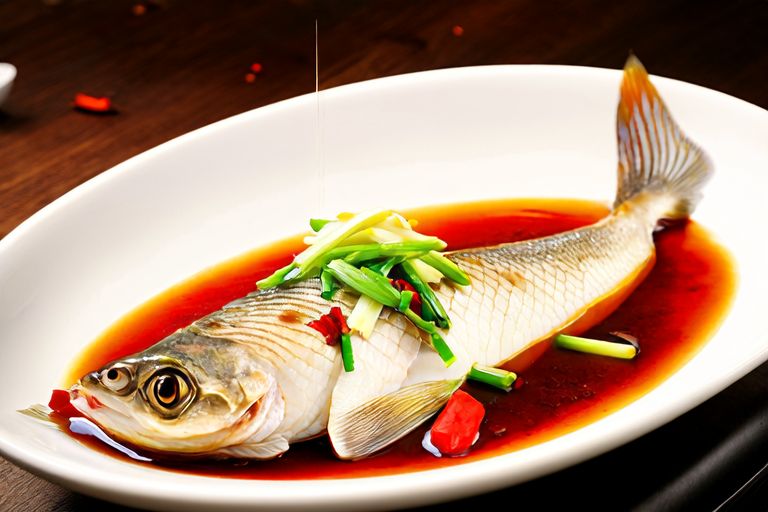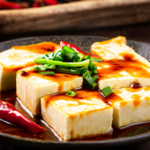- Introduction to Steamed Fish in Zhejiang Style
The art of cooking is as much about the ingredients as it is about technique and presentation. In the vast culinary landscape of China, each region has its own unique style and flavor profile. Among these, the cuisine of Zhejiang stands out for its emphasis on freshness, simplicity, and the delicate balance between flavors. One of the most iconic dishes from this region is Steamed Fish in Zhejiang Style (清蒸鱼), which not only showcases the province’s commitment to preserving the natural flavors of its ingredients but also highlights the importance of seasonal produce.
In spring, when the air is filled with the scent of blooming flowers and the earth awakens from its winter slumber, fresh fish becomes a symbol of renewal and vitality. The mild, clean taste of steamed fish perfectly complements the season, offering a light yet satisfying meal that celebrates the arrival of spring. This dish is often served at family gatherings and special occasions, where it is appreciated for its simplicity and the way it brings people together around the table.
- Ingredients
To prepare this dish, you will need:
- 1 whole freshwater fish (such as grass carp or silver carp), approximately 1-1.5 kg
- 2 tablespoons of Shaoxing rice wine
- 1 teaspoon of salt
- 1 tablespoon of soy sauce
- 1 teaspoon of sugar
- 2 teaspoons of sesame oil
- 3-4 slices of ginger
- 3-4 green onions, cut into thin strips
- 1 red chili, sliced thinly (optional)
- 1/2 cup of chicken broth or water
- 2 tablespoons of vegetable oil
- 1 teaspoon of white pepper
- 1 teaspoon of sesame seeds (for garnish)
Ensure that the fish is fresh and of good quality. If possible, choose a fish with firm flesh and bright eyes. The freshness of the fish is crucial for this dish, as it is prepared using minimal seasoning to allow the natural flavors to shine through.
- Preparation
Before starting, make sure all your ingredients are prepped and ready. Clean the fish thoroughly under cold running water, removing any scales and internal organs. Pat the fish dry with paper towels. Season the inside of the fish with salt and white pepper, then place it in a shallow dish or steamer basket. Sprinkle the fish with slices of ginger and green onions, and pour in the Shaoxing rice wine and soy sauce.
Heat the vegetable oil in a small pan over medium heat. Once hot, pour the oil evenly over the fish, ensuring that it coats the surface of the fish and the inner cavity. This step helps to seal in the flavors and ensures that the fish remains moist during the steaming process.
Prepare a steamer by adding enough water to reach just below the bottom of the steamer basket. Place the fish in the steamer basket and cover it with a lid. Steam the fish for about 8-10 minutes per 500 grams of fish weight. Use a toothpick or skewer to check if the fish is cooked through by inserting it into the thickest part of the fish; if it comes out clean, the fish is done.
- Garnishing and Serving
Once the fish is fully cooked, remove it from the steamer and transfer it to a serving platter. Pour the juices from the steaming dish over the fish, enhancing its flavor. Garnish the fish with additional slices of ginger, green onions, and red chili if desired. Drizzle a little sesame oil over the top for added aroma and richness.
Serve the steamed fish immediately, accompanied by steamed rice and a side of stir-fried vegetables. The contrast between the tender, flavorful fish and the crisp vegetables creates a delightful dining experience. You can also add a small bowl of soy sauce mixed with a bit of vinegar for dipping, allowing diners to adjust the seasoning to their liking.
- Cultural Significance
Steamed Fish in Zhejiang Style is more than just a dish; it is a reflection of the cultural values and traditions of the Zhejiang region. The preparation method emphasizes the importance of preserving the natural flavors of the ingredients, a philosophy that is deeply rooted in Chinese culinary culture. The use of simple, high-quality ingredients and minimal seasoning allows the true essence of the fish to be experienced, embodying the concept of ‘less is more’ in cooking.
This dish is often associated with spring, a time of renewal and growth. The gentle steaming process mirrors the slow awakening of nature after winter, while the use of fresh, seasonal ingredients celebrates the abundance of the season. In traditional Chinese medicine, fish is believed to have nourishing properties, making it an ideal food for rejuvenation and health.
- Conclusion
Steamed Fish in Zhejiang Style is a testament to the beauty of simplicity in cooking. By focusing on the quality of the ingredients and the careful execution of the cooking process, this dish offers a harmonious blend of flavors that is both comforting and elegant. Whether enjoyed at home or in a restaurant, this dish invites you to savor the moment and appreciate the artistry of Chinese cuisine. As you take your first bite, you’ll be transported to the lush landscapes of Zhejiang, where the fresh breeze carries the scent of spring and the promise of new beginnings.


